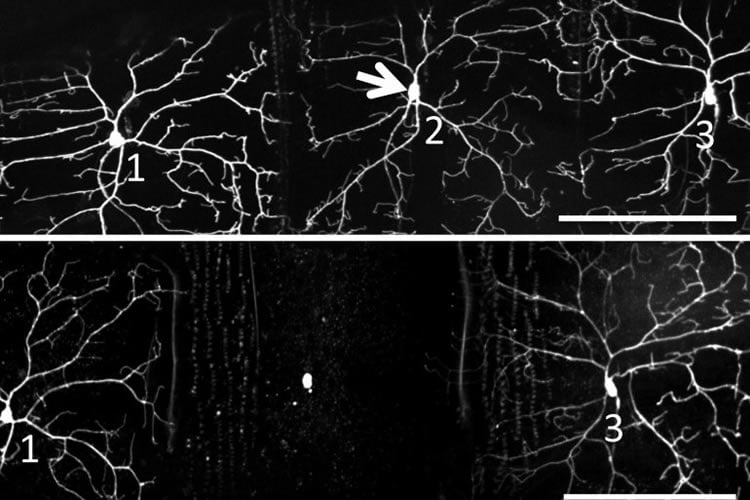Summary: Researchers have developed a new optogenetics tool that can remove single cells from brain networks in living animals.
Source: UCSF.
The human brain may be the most complex object in the universe – 86 billion cells of many different types making more than 100 trillion information-bearing connections. This complexity is a daunting prospect for researchers hoping to unravel how the brain’s intricately interwoven networks produce both normal cognition and neurological disease.
As usual when confronted with an overwhelming problem, it’s best to start small. In the past 10 years, neuroscientists have developed so-called “optogenetic” tools that let them use beams of light to turn particular cells or networks of cells on and off with both genetic and spatial precision. Using these tools, researchers hope to reverse engineer the principles of brain function.
Now researchers at UC San Francisco have developed a new optogenetic tool that can be used to completely eliminate single cells from brain networks in live animals. The researchers believe the new tool – called miniSOG2 – will enable exquisitely precise experiments to help researchers understand how each cell contributes to the whole.
In an experiment, researchers used peripheral neurons in a live fruit fly that were genetically modified to express miniSOG2 as well as a protein that makes the cells glow. The researchers then exposed the number two neuron to a particular wavelength of blue light that triggers miniSOG2 to generate reactive oxygen specifies, and thus exposing the cell to the toxic molecules and eventually leading the cell to self-destruct. In a second image taken 24 hours later, this neuron has vanished, but the other two neurons that were not exposed to blue light remain intact.

In a second experiment, the researchers set out to show that the new technique could be used to study all kinds of cells – not just neurons. They found that getting rid of certain developing cells in the fly larva led to specific changes in the structure of the wings of the adult fly, demonstrating the utility of the new technique for studing how individual cells contribute to the development of the organism.
“Many diseases are caused by death of certain important cells,” said Xiaokun Shu, PhD, an assistant professor of pharmaceutical chemistry in the UCSF School of Pharmacy and senior author of a new study about the new optogenetic tool that was published in Cell Chemical Biology on Jan. 5, 2017. “For example, Parkinson’s disease is caused by death of a specific group of neurons called dopaminergic neurons in part of the brain called the substantia nigra. We can use our probe to model the loss of particular types of neurons in animals, which should lead to a more precise understanding of these cells’ normal functions, as well as new ways to test therapeutics against this kind of disease.”
Source: Nicholas Weiler – UCSF
Image Source: NeuroscienceNews.com image is credited to Xiaokun Shu.
Original Research: Abstract for “Precision Optogenetic Tool for Selective Single- and Multiple-Cell Ablation in a Live Animal Model System” by Kalpana Makhijani, Tsz-Leung To, Rubén Ruiz-González, Céline Lafaye, Antoine Royant, and Xiaokun Shu in Cell Chemical Biology. Published online January 5 2017 doi:10.1016/j.chembiol.2016.12.010
[cbtabs][cbtab title=”MLA”]UCSF “Using Light to Make Single Cells Self-Destruct.” NeuroscienceNews. NeuroscienceNews, 6 January 2017.
<https://neurosciencenews.com/optogenetics-apoptosis-5876/>.[/cbtab][cbtab title=”APA”]UCSF (2017, January 6). Using Light to Make Single Cells Self-Destruct. NeuroscienceNew. Retrieved January 6, 2017 from https://neurosciencenews.com/optogenetics-apoptosis-5876/[/cbtab][cbtab title=”Chicago”]UCSF “Using Light to Make Single Cells Self-Destruct.” https://neurosciencenews.com/optogenetics-apoptosis-5876/ (accessed January 6, 2017).[/cbtab][/cbtabs]
Abstract
Precision Optogenetic Tool for Selective Single- and Multiple-Cell Ablation in a Live Animal Model System
Highlights
•An efficient photosensitizer miniSOG2 is engineered using directed evolution
•miniSOG2 enables precision photoablation of single neurons in live Drosophila
•miniSOG2 allows optogenetic ablation of cells in wing imaginal disc
Summary
Cell ablation is a strategy to study cell lineage and function during development. Optogenetic methods are an important cell-ablation approach, and we have previously developed a mini singlet oxygen generator (miniSOG) tool that works in the living Caenorhabditis elegans. Here, we use directed evolution to generate miniSOG2, an improved tool for cell ablation via photogenerated reactive oxygen species. We apply miniSOG2 to a far more complex model animal system, Drosophila melanogaster, and demonstrate that it can be used to kill a single neuron in a Drosophila larva. In addition, miniSOG2 is able to photoablate a small group of cells in one of the larval wing imaginal discs, resulting in an adult with one incomplete and one normal wing. We expect miniSOG2 to be a useful optogenetic tool for precision cell ablation at a desired developmental time point in live animals, thus opening a new window into cell origin, fate and function, tissue regeneration, and developmental biology.
“Precision Optogenetic Tool for Selective Single- and Multiple-Cell Ablation in a Live Animal Model System” by Kalpana Makhijani, Tsz-Leung To, Rubén Ruiz-González, Céline Lafaye, Antoine Royant, and Xiaokun Shu in Cell Chemical Biology. Published online January 5 2017 doi:10.1016/j.chembiol.2016.12.010






